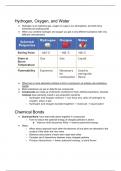Class notes
CHEM 130 Chapter 4: Molecules and Compounds
- Course
- Institution
Class notes for Chapter 4: Molecules and Compounds in the class General Chemistry: Macroscopic Investigations and Reaction Principles (CHEM 130) at the University of Michigan. Topics covered include chemical bonding, chemical formulas, molecular models, bonding, mathematical formulas relating to co...
[Show more]



